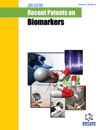- Home
- A-Z Publications
- Recent Patents on Biomarkers (Discontinued)
- Previous Issues
- Volume 4, Issue 2, 2014
Recent Patents on Biomarkers (Discontinued) - Volume 4, Issue 2, 2014
Volume 4, Issue 2, 2014
-
-
Evolution and Pathogenesis of Oncoviruses Associated with Head and Neck Cancer: History and Current Concepts
More LessAuthors: Kiran B. Jadhav, Sayeed M. Rahaman, Nidhi Gupta and Vandana ShahNearly hundred years back the first oncovirus Rous Sarcoma Virus (RSV) was isolated. From then onwards, researchers have isolated many viruses associated with human cancer. This review summarizes all the oncoviruses in brief and in detail including Human Papilloma Virus (HPV), Epstein-Barr virus (EBV) and Cytomegalo Virus (CMV). This review also discusses about various past and recent patents published in relation to t Read More
-
-
-
p16INK4 as a Biomarker in Oropharyngeal Squamous Cell Carcinoma
More LessAuthors: Mario Nava-Villalba, Saray Aranda-Romo and Gerardo Meza-GarciaThe oropharyngeal squamous cell carcinomas (OPSCC) are a molecular and clinically heterogeneous group of cancer, not yet fully characterized. The most important risk factors for OPSCC are tobacco and alcohol, however, in the last fifteen years, HPV-positive OPSCC are apparently growing, principally in young male people. It is highly probable that these cases represent a new and particular OPSCC subgroup. A reclassificatio Read More
-
-
-
Investigation of Human Papilloma Virus Associated with Oral Cancer with an Insight into Diagnostic Approaches and Recent Patents
More LessAuthors: Shelly Arora and Kiran JadhavHead and neck squamous cell carcinomas (HNSCC) are the sixth most common cancers worldwide, accounting for 633000 new cases annually. The etiology of HNSCC is considered to be multifactorial. Smoking and excessive alcohol consumption are well-established risk factors for HNSCCs. Human Papilloma Virus (HPV) particularly subtype 16 has been proposed as a risk factor in Oral squamous cell carcinoma (OSCC) develo Read More
-
-
-
Role of Cytomegalovirus in Salivary Gland Tumors: An Unfolded Mystery
More LessAuthors: Nidhi Gupta, Kiran B. Jadhav and Vandana ShahPast two decades have seen a tremendous bloom in cancer research, especially considering the biomarkers. Cancer related biomarkers have indeed opened new horizons in the areas of cancer diagnosis, care, therapeutics and prognosis. Oncoviruses and their role in various oral cancers have also been an intensive area of qualitative research. This paper reviews the researches and patents relating to Cytomegalovirus (C Read More
-
-
-
Biomarkers of Organ Injury
More LessA molecular biomarker is an entity whose release, abundance and/or modification state is altered as a result of injury or disease, and can be used to aid diagnosis. The concentrations of injury biomarkers are typically highest within the injured organ, but may be measurable in body fluids. Injuries such as trauma often result in damage to multiple organs, requiring biomarkers that can specifically identify the organs that are Read More
-
-
-
Virulence Factors of Helicobacter pylori: Practical Biomarkers
More LessHelicobacter pylori are the main cause of gastritis, peptic ulceration and distal gastric adenocarcinoma. Bacterial virulence factors actively contribute in the clinical outcome and progression of Helicobacter pylori infection. The wide range of digestive disease attributed with Helicobacter pylori infection has led scientists to a huge interest in biomarkers. Thus, determination of a biomarker as practical patent for each infecti Read More
-
-
-
Patents in Diagnosis of Preeclampsia
More LessBy Kharb SimmiPreeclampsia is an important cause of morbidity and mortality of mother and fetus. Preeclampsia is characterized by hypertension and proteinuria occurring during the last trimester of pregnancy. In this review, an attempt is be done to discuss mechanisms of preeclampsia with an emphasis on diagnostic markers of preeclampsia and its complications along with patents available in this aspect.
-
-
-
Biomarkers for VEGF-Targeted Therapy in Renal Cell Carcinoma: Critical Review of Level of Evidence and Up to Date
More LessBackground: Metastatic Renal Cell Carcinoma (mRCC) is a malignancy with a poor prognosis due to inefficacy of chemotherapy and to the efficacy of immunotherapy only in few patients. The availability of agents directly targeting tumorigenic and angiogenic pathways, as Vascular Endothelial Growth Factors (VEGF) inhibitors, has significantly improved the outcome of these patients. Aim of this work is to evaluate the possible p Read More
-
Volumes & issues
Most Read This Month
Article
content/journals/rpbm
Journal
10
5
false
en


